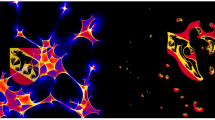Abstract
A procedure for calculating two-dimensional power spectra of microlensing magnification fields is presented. In the absence of a shift, the one-dimensional projections of the power spectra P(k) corresponding to the light curve of a point source moving in a linear trajectory can be approximated by the expression (a 2 + k 2)−1/2 (where a = const). The power spectrum of an extended source is treated like the product of the power spectrum of a point source and the power spectrum of the brightness distribution of the extended source. The effect of the extent of the source is that it acts like a filter, suppressing high-frequency components in the spectrum. Based on eight years of monitoring of the quad gravitational lens Q2237+0305 by the OGLE group, power spectra for all four images are constructed and the (temporal) size of the radiating region of the quasar in the V filter is estimated to be 24 ± 6 days; given the constraints on the transverse velocity of the lensing galaxy (<600 km/s), the linear size turns out to be <1015 cm.
Similar content being viewed by others
References
K. Chang and S. Refsdal, Nature 282, 561 (1979).
D. Walsh, R. F. Carswell, and R. J. Weymann, Nature 279, 381 (1979).
M. J. Irwin, R. L. Webster, P. C. Hewett, et al., Astron. J. 98, 1989 (1989).
F. Courbin, in Gravitational Lensing: An Astrophysical Tool, Ed. by F. Courbin and D. Minniti (Springer-Verlag, Berlin, 2002), Lect. Notes Phys. 608, 1 (2002).
V. N. Shalyapin, L. J. Goicoechea, D. Alcalde, et al., Astrophys. J. 579, 127 (2002).
M. J. Mortonson, P. L. Schechter, and J. Wambsganss, Astrophys. J. 628, 594 (2005).
J. Wambsganss, J. Comput. Appl. Math. 109, 353 (1999).
V. N. Shalyapinxxx Pis’ma Astron. Zh. 27, 1 (2001) [Astron. Lett. 27, 150 (2001)].
A. Yonehara, Astrophys. J. 548, L127 (2001).
C. S. Kochanek, Astrophys. J. 605, 58 (2004).
Dong-Wook Lee, J. Surdej, O. Moreau, et al., Astron. Astrophys. 436, 479 (2005).
C. Seitz and P. Schneider, Astron. Astrophys. 288, 1 (1994).
C. Seitz, J. Wambsganss, and P. Schneider, Astron. Astrophys. 288, 19 (1994).
G. F. Lewis and M. J. Irwin, Mon. Not. R. Astron. Soc. 283, 225 (1996).
B. Neidorf, Astron. Astrophys. 404, 83 (2003).
M. R. S. Hawkins, Astrophys. J. 553, L97 (2001).
V. N. Shalyapinxxx Astron. Zh. 72, 668 (1995) [Astron. Rep. 39, 594 (1995)].
S. Deguchi and W. D. Watson, Phys. Rev. Lett. 59, 2814 (1987).
A. Papoulis, Systems and Transforms with Applications in Optics (McGraw-Hill, New York, 1968; Mir, Moscow, 1971).
G. Arfken, Mathematical Methods for Physicists (Academic, New York, 1966; Atomizdat, Moscow, 1970).
R. Ostensen, S. Refsdal, R. Stabell, et al., Astron. Astrophys. 309, 59 (1996).
D. Alcade, E. Mediavilla, O. Moreau, et al., Astrophys. J. 572, 729 (2002).
E. Koptelova, E. Shimanovskaya, B. Artamonov, et al., Mon. Not. R. Astron. Soc. 356, 323 (2005).
P. R. Woźniak, C. Alard, A. Udalski, et al., Astrophys. J. 529, 88 (2000).
N. R. Lomb, Astrophys. Space Sci. 39, 447 (1976).
J. D. Scargle, Astrophys. J. 263, 835 (1982).
W. H. Press, B. P. Flannery, S. A. Teukolsky, and W. T. Wettering, Numerical Recipes (Cambridge Univ. Press, Cambridge, 1997).
G. M. Jenkins and D. G. Watts, Spectral Analysis and Its Applications (Holden-Day, San Francisco, 1966; Mir, Moscow, 1971), Vol. 1.
P. L. Schechter, J. Wambsganss, and G. F. Lewis, Astrophys. J. 613, 77 (2004).
J. S. B. Wyithe, R. L. Webster, and E. L. Turner, Mon. Not. R. Astron. Soc. 309, 261 (1999).
R. Gil-Merino, J. Wambsganss, L. Goicoechea, and G. Lewis, Astron. Astrophys. 432, 83 (2005).
Author information
Authors and Affiliations
Additional information
Original Russian Text © V.N. Shalyapin, 2006, published in Astronomicheskiĭ Zhurnal, 2006, Vol. 83, No. 9, pp. 784–793.




